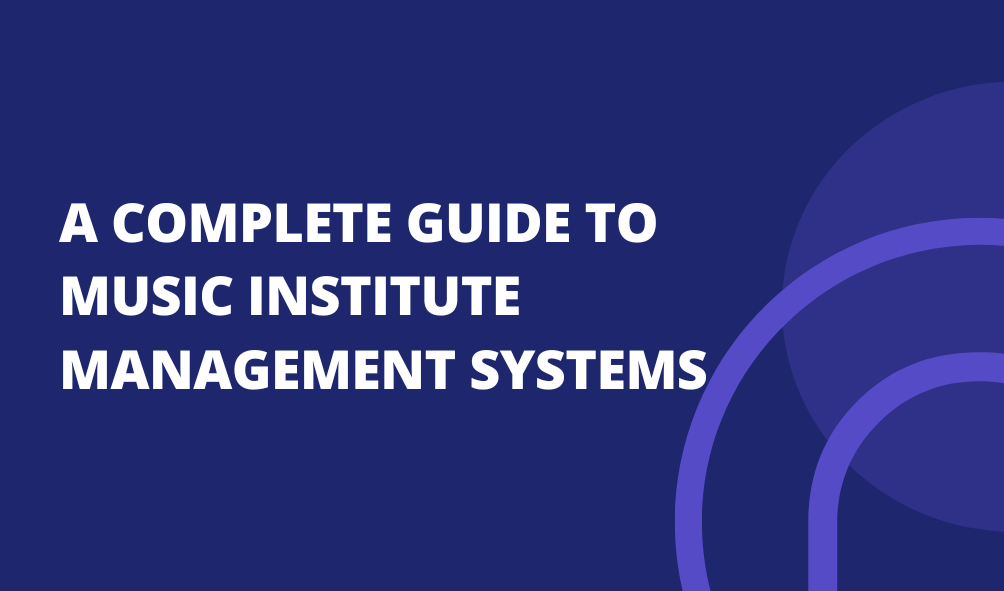5 Key Benefits Of Using A Music Institute Management System
5 Key Benefits of Using a Music Institute Management System
Managing a music institute involves multiple responsibilities, from scheduling lessons and tracking student progress to handling invoices and teacher assignments.
Without an efficient system, these tasks can become huge, leading to administrative errors, missed lessons, and mismanaged finances.
This is where Music Management Software comes into play. A well-structured Music Institute Management System helps automate operations, providing smooth coordination between students, teachers, and administrators.
With features like class scheduling, attendance tracking, and seamless fee management, this software enhances efficiency and allows music institutes to focus on what truly matters—providing quality education.
In this blog, we will explore the five key benefits of using a Music Management Software and how it can revolutionize the way music schools operate.
What is Music Management Software?
Music Management Software is a specialized digital solution designed to streamline the administrative and operational tasks of music institutes. It acts as an all-in-one platform that helps manage student records, class schedules, attendance tracking, fee collection, teacher assignments, and much more.
With the rise of Music Institute Management Systems, traditional paper-based administration is becoming obsolete. These advanced systems offer cloud-based access, allowing music schools to efficiently organize their operations from anywhere.
Whether you're managing a small academy or a large-scale music institute, the right Music School Software ensures smooth coordination between students, instructors, and administrators—enhancing the overall learning experience.
In the next section, we will explore the key benefits of implementing a Music Management System in your institute.
5 Key Benefits of Using Music Management Software
Implementing a Music Management Software can significantly improve the efficiency of a music institute. From better organization to data-driven decision-making, this system enhances various aspects of daily operations. Below are the five key benefits of using a Music Institute Management System.
1. Enhanced Organization
Managing student records, lesson schedules, and teacher assignments manually can lead to confusion and errors. With a Music Management System, all essential data is stored in one place, making it easy to access and update. This reduces paperwork, ensures accurate record-keeping, and helps administrators manage operations seamlessly.
2. Improved Accessibility
A cloud-based Music Management Software allows students, teachers, and administrators to access schedules, assignments, and payment details from anywhere. Whether a student wants to check their next lesson or an instructor needs to update attendance, the system provides real-time access, improving communication and transparency.
3. Increased Efficiency
By automating essential tasks like fee collection, attendance tracking, and class scheduling, music institutes can save valuable time and reduce manual effort. This efficiency allows teachers to focus more on delivering quality lessons rather than managing administrative tasks.
4. Data-Driven Decisions
With built-in analytics and reporting features, Music School Software helps institutes track student progress, analyze attendance trends, and monitor financial records. These insights enable administrators to make informed decisions, optimize resource allocation, and improve the overall learning experience.
5. Better Communication and Coordination
A Music Institute Management System enhances communication by sending automated notifications for class updates, fee reminders, and schedule changes. It also facilitates smooth coordination between students, parents, and instructors, ensuring that everyone stays informed and engaged.
By integrating Music Management Software, institutes can create a well-structured and efficient learning environment. In the next section, we will explore the additional features that further enhance the functionality of these systems.
Key Features of Music Management Software
A Music Institute Management System comes with a variety of features designed to streamline operations and improve efficiency. These features help automate administrative tasks, enhance student learning experiences, and ensure seamless coordination between teachers and students. Below are some of the essential features of Music Management Software.
1. Role-Based Access Control
With multiple users accessing the system, role-based access control ensures that administrators, teachers, and students have the right permissions. This enhances security and prevents unauthorized access to sensitive information.
2. Class and Lesson Management
Scheduling and managing music lessons can be complex, especially in large institutes. The software allows administrators to create, modify, and assign lessons efficiently, ensuring smooth class operations.
3. Attendance Management
Tracking student attendance manually can be time-consuming. Music School Software automates attendance recording, providing real-time updates and absentee reports to keep administrators informed.
4. Invoice and Fee Management
Handling payments and generating invoices can be a challenge for music institutes. With integrated billing features, the system automates fee collection, sends payment reminders, and generates invoices, reducing administrative workload.
5. Seamless Integration
The best Music Management Software integrates with other tools like accounting software, communication platforms, and online payment gateways. This ensures a smooth workflow and eliminates the need for manual data entry.
6. Instrument Management
For music schools that provide instrument rentals, this feature helps track instrument availability, condition, and due dates, preventing mismanagement and losses.
7. Absentee Reports
The system generates reports on student absences, allowing administrators and teachers to track attendance trends and take necessary actions to improve student participation.
8. Teacher Assignments
Assigning teachers to specific classes, lessons, or students becomes effortless with automated scheduling. The system also allows easy rescheduling in case of teacher unavailability.
9. Reporting & Analytics
With built-in reporting tools, administrators can track key metrics such as student performance, attendance trends, and financial summaries. These insights help in making informed decisions for the institute’s growth.
By leveraging these features, a Music Institute Management System helps institutes run smoothly, reduce administrative burdens, and improve the overall learning experience.
Conclusion
In today’s digital era, managing a music institute manually can be overwhelming. From student enrollment and lesson scheduling to fee management and reporting, a Music Institute Management System streamlines every aspect of operations, making administration more efficient and organized.
By implementing a Music Management Software, institutes can improve organization, accessibility, efficiency, and decision-making while ensuring seamless communication between students, teachers, and administrators. With essential features like role-based access, class management, attendance tracking, and financial automation, this software provides a complete solution to manage and grow a music institute effectively.







